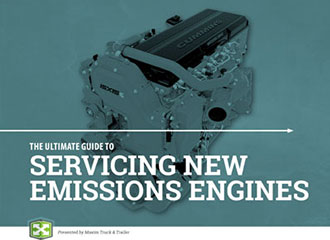
16 QUESTIONS TO ASK ABOUT SERVICING NEW HEAVY DUTY EMISSIONS ENGINES
 It was a lot easier (and cheaper) to be a trucker and service your machinery before society knew about the fragile state of the environment and the pollutants that diesel fuel and inefficient engines spew into the atmosphere.
It was a lot easier (and cheaper) to be a trucker and service your machinery before society knew about the fragile state of the environment and the pollutants that diesel fuel and inefficient engines spew into the atmosphere.Regulations from the Environmental Protection Agency (EPA) are evolving and becoming stricter with every passing year and engine builders and designers are being pushed to clean up their acts in the reduction of harmful exhaust from diesel engines.
Kyle Cuthbert, Senior VP of Service & Operations at Maxim Truck & Trailer in Winnipeg, would like to help you stay up to speed on running and servicing new emissions engines.
Kyle Cuthbert, Senior VP of Service & Operations at Maxim Truck & Trailer in Winnipeg, would like to help you stay up to speed on running and servicing new emissions engines.
VIEW MAXIM'S SERVICE HOMEPAGE
| 1 | What classifies as a big bore engine? Big bore is a term that signifies that size of the engine. It’s anything 12 litres and higher. Truck manufacturers today are building their trucks from bumper to bumper with exclusive components. That helps with their profit margins and servicing because they don’t have to go to another manufacturer to buy an engine with higher purchase and handling costs. |
| 2 | What is SCR technology? Selective catalytic reduction is the state-of-the-art technology we use today. You inject urea, also known as diesel exhaust fluid, into the exhaust system while you’re driving. This chemical reduces nitrous oxide in the exhaust to very low levels. The good news is SCR technology reduces the percentage of exhaust gas being recirculated back into the engine, thereby helping the engine to run cleaner and longer |
| 3 | What’s changing with Class 8 engine warranties today? They are shorter than they used to be and are becoming shorter industry-wide. Basic warranties today in big bore engines are two years. Some warranties were up to five years prior to 2006. The whole industry is adjusting to it. You can buy added warranty but there’s even less of that now, too. Warranties aren’t as comprehensive as they used to be. The general trend in engine life expectancy is struggling to hold on despite better materials being used. |
| 4 | What is ‘regeneration’? Regeneration is the term to describe the onboard process by which the soot in the Diesel Particulate Filter (DPF) is reduced to fly ash. This function derestricts the DPF so that engine exhaust back pressure is restored to normal. The engine control module will put the engine through a regeneration, which is a mode to clean up the soot that has accumulated in the diesel particulate filter, or DPF. All newer engines have it. You inject diesel fuel into the exhaust stream and it will make the exhaust burn hotter, creating a temperature of about 1,100 degrees Fahrenheit in the DPF, which is part of the muffler. That will burn off the soot build up and turn it into ash. There are three types of regeneration – passive, active and parked. Passive regeneration is achieved when the engine exhaust is running hot enough to burn off soot with no added driver or engine control inputs. Active regeneration is achieved similar to passive but where more exhaust heat is required, the after treatment injector or doser will inject more fuel into the exhaust stream after the turbo charger. There’s also the parked regeneration, where you’ve got to pull over to the side of the road. That’s where the build up is so high in the DPF that it will tell you it needs a thorough cleaning by hitting a switch on the dash and the system will do it by itself. This process can take up to 20 minutes to complete. |
| 5 | How important is driver/operator training in using today’s engines? It’s critical, but it’s a big problem in the industry. Users of these vehicles need to train their operators how to work with the regeneration processes of these engines. If they don’t understand it, they may bypass the regeneration process. If a driver decides he’s in an unsafe situation, he can postpone a regeneration. Sometimes it gets to the point where the DPF is so plugged that it derates that engine and can shut it right off. Then you’ve got to get a tow truck and that’s when everybody gets upset because there’s less reliability, more downtime and more recovery costs. |
| 6 | How important is it to follow manufacturer’s recommendations for proper engine maintenance? This is also critical. The maintenance needs of these engines are greater than ever before with proper lubricating oils, drain intervals and filtration. You need the best filtration, you don’t want to compromise on that. If you do, that will lead to reduced engine reliability, reduced engine life and possibly a loss of warranty. |
| 7 | What recommendations are there for using diesel fuel additives today? There are more recommendations for using diesel fuel additives year round than ever before and there are additives that are showing great benefit. Though there is lots of ‘snake oil’ out there, so choose carefully. Chemical companies are very serious about improving the performance of these diesel engines. Diesel fuel additives today remove water, save injectors and help create more heat when they burn the fuel. That raises the exhaust temperatures, which is a good thing where regenerations are concerned. |
| 8 | What is a DPF and how should it be maintained for maximum life? You should take a Diesel Particular Filter off the vehicle and extract the ash build up. The usage of the engine in the vehicle determines the cleaning cycles for the DPF. It depends on how much you use the vehicle, and that’s the rub. Today, most trucks are going down the road and not getting serviced until the light comes on the dash, that’s too late. You have to catch it before it comes on. That’s the hard part. It’s a learning curve. Drivers learn by how they utilize the vehicle to be able to establish their DPF cleaning patterns. For a long-haul carrier, it might be once every 350,000 km. For a regional short haul carrier that does a lot of idling, it will probably need servicing more, say every 150,000 km. The point is that when DPF cleaning is performed at the optimal time, better engine performance, fuel economy and longer DPF life expectancy is achieved. |
| 9 | What are some cold weather recommendations for good engine performance? Use a winter front. It’s like a cover over the radiator. Second, reduce or eliminate the engine idling. No diesel engine ever built does well with prolonged idling. It’s destructive to the engine and the environment in every case. A lot of drivers, when they’re parked, run the engine around the clock. That’s murder on the engine and its emission control system. You can buy different types of add-on cab heater systems now so you can shut the engine off. Many drivers today will stay in the cab and have an auxiliary heating system on board and the engine shut off. Using fuel additives is good, too, because it helps the engine perform in harsh weather. |
| 10 | What about some hot weather recommendations? A couple of things happen in the summer. First, the fuel quality gets better, there’s more paraffin in it, so it burns hotter and the emission system works better because it’s not fighting the cold. Second, instead of having the heat on, drivers have the air conditioning on. They’ll leave the engine running with the AC cranked when it’s hot outside. Fuel is expensive. When the engine is just idling, it plugs up the EGR coolers and the DPF. Once again, the answer is shut the engine off and get a cab cooling system. |
| 11 | What’s going on with truck cab auxiliary heaters and coolers? There are more of them now than ever before. The industry is really picking up on that so the installation and usage of them is on the upswing, which is very good. It allows the drivers to shut the engine off and still have in cab comfort for sleeping or resting. In some jurisdictions now, it’s illegal to sleep with the engine running. They may fine you if they catch you, summer time or winter time, it doesn’t matter. |
| 12 | How important is it to spec the truck exhaust system properly? The exhaust emissions equipment on any newer truck is very valuable. You can’t modify it. When you order a new truck, you can get mufflers that go underneath the vehicle or up the back of the cab. You need to select the right one so you never have to modify that equipment. It’s too expensive. |
| 13 | What is an exhaust system ‘delete’? This is when someone will go in and modify the exhaust emissions equipment on a diesel engine. Frankly, a “delete” engine may run better and longer with greater fuel economy but the risks in doing this outweigh the benefits. Your engine warranty goes away in this case, also. |
| 14 | What is the risk of fire during regeneration and why? The temperature in the DPF chamber can reach 1,100 degrees Fahrenheit. The risk of fire comes with that and anything near that DPF section could ignite. Cars have the same problem. Don’t park in tall grass. |
| 15 | What is OBD 2 all about and why is it in today’s trucks? It’s a technology called on-board diagnostics. In cars for many years, they’ve been using OBD1 and OBD2, which are systems of engine fault codes that are becoming common now. All of the engine builders are sharing a common trouble code system for engines, whether it’s cars or trucks. Consumers have demanded it. Truck fleets today may use three or four different brands of equipment and they want to have a common system for managing engine trouble codes. |
| 16 | Why are engine ECMs recalibrated from time to time and should they be kept up? Yes, because manufacturers are always improving their products. It’s often done to manage exhaust emissions to an even higher level, which can also help the engine run better. The message to anybody driving a vehicle today is if there’s a recall recalibration for that vehicle, they should get it done. It can improve engine performance and emissions. |






